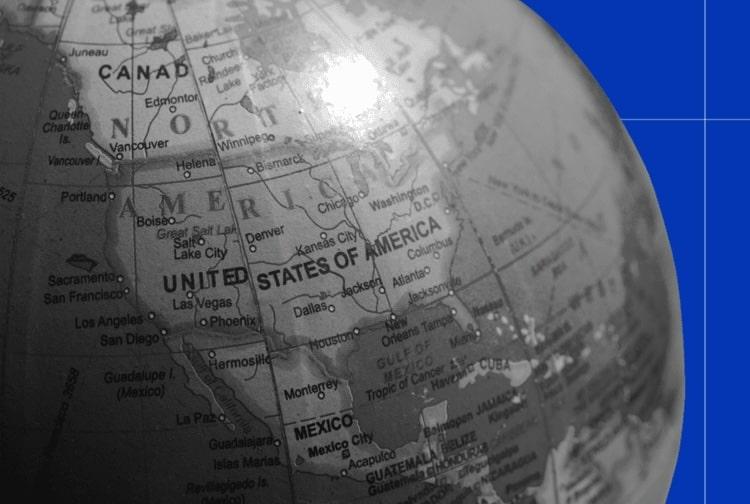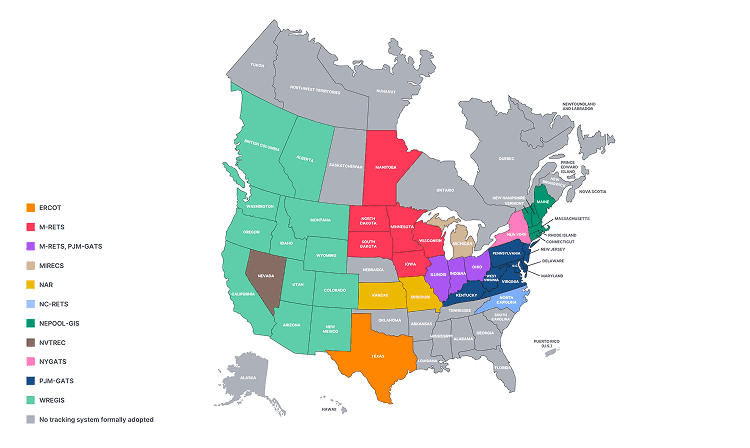Understanding the US REC Registries: A Complete Overview

U.S. renewable energy certificates known as RECs or US RECs are tracked through regional systems that manage their issuance, ownership, and retirement. These certificate tracking systems are used across North America, including in Canada, to prevent double counting and confirm exclusive ownership of each megawatt-hour of renewable electricity. The U.S. and Canada do not operate under a single national registry. Instead, they rely on a patchwork of regional tracking systems that together provide full geographic coverage. This structure shapes how RECs are tracked, with ten major registries aligned to specific electricity markets or state groupings. Each is operated by a designated administrator—often a grid operator or a contracted service provider. This distributed approach allows for consistency in certificate tracking while accommodating the structure of the broader North American power market. Below is a list of the major U.S. REC registries, their coverage, and their scope.
List of US REC Tracking Systems

WREGIS
The Western Renewable Energy Generation Information System (WREGIS) tracks RECs for renewable energy generated across the western U.S., as well as parts of Canada and Mexico. It supports both state compliance programs and voluntary market activity within the region. Generators must be located in the western grid area to participate.
M-RETS
The Midwest Renewable Energy Tracking System (M-RETS) began as a regional registry but now accepts generators from anywhere in the U.S. or Canada. It supports state compliance programs in the Midwest and is widely used for voluntary REC transactions. Its national scope makes it a key platform for unbundled, voluntary RECs, including those from regions without a local registry.
NAR
The North American Renewables Registry (NAR) allows renewable energy projects across the U.S. and Canada to register and receive RECs. It's especially useful in states without a dedicated registry and is widely used for voluntary, unbundled RECs.
PJM-GATS
The Generation Attribute Tracking System (GATS) covers the mid-Atlantic and parts of the Midwest U.S. It supports state RPS compliance and some voluntary use. Participation is limited to generators in PJM or approved adjacent areas. It does not register Canadian projects or nationwide voluntary RECs.
NEPOOL-GIS
The New England Power Pool Generation Information System (NEPOOL-GIS) tracks all electricity generation in the New England region. It supports both RPS compliance and voluntary REC tracking within New England only. The system does not register Canadian projects.
ERCOT
The Texas Renewable Energy Credit Program, managed by ERCOT, tracks RECs for renewable generation within Texas only. It supports the state's Renewable Electricity Requirement and voluntary REC use. Generators must be located in-state, and the system does not include Canadian projects.
NYGATS
The New York Generation Attribute Tracking System (NYGATS) tracks RECs and all generation attributes for New York State. It supports the state's Clean Energy Standard and voluntary RECs. While focused on in-state generation, NYGATS can transfer credits with other registries like NEPOOL or NAR. It does not register Canadian projects.
MIRECS
The Michigan Renewable Energy Certification System (MIRECS) tracks RECs for renewable generation within Michigan. It supports the state's RPS and voluntary REC use. While focused on Michigan, MIRECS can exchange credits with registries like M-RETS or NAR when policy allows. It does not register Canadian projects directly.
NC-RETS
The North Carolina Renewable Energy Tracking System (NC-RETS) tracks RECs and energy efficiency credits for compliance. It primarily serves in-state generators and NC-based voluntary buyers. NC-RETS can accept REC transfers from other registries like NAR or NYGATS but does not register Canadian projects.
NVTREC
The Nevada Tracks Renewable Energy Credits system (NVTREC) supports the state's Renewable Portfolio Standard for in-state renewable generation and energy efficiency. It is focused on compliance use within Nevada and does not support voluntary REC transactions. Voluntary buyers in Nevada typically use WREGIS instead.
REC Tracking in Non-Registry States
In states without a dedicated REC registry, generators and buyers typically rely on national platforms like M-RETS or NAR. These systems are designed to accommodate projects from anywhere in the U.S. and are widely used to fill gaps where no state-level system exists.
Difference between REC registries
REC tracking systems in the U.S. differ in scope and function. Some serve single states—like NYGATS, MIRECS, NC-RETS, and ERCOT—while others operate across multiple states or regions, such as PJM-GATS, NEPOOL-GIS, and WREGIS. Two registries, M-RETS and NAR, stand out for their national coverage. They accept generators from anywhere in the U.S. and Canada and are especially important for voluntary, unbundled RECs and for states without their own tracking system. Despite their differences, most registries can connect through bilateral agreements, allowing RECs to be transferred across systems when policies permit. Each registry assigns a unique serial number to every REC and records key details like the facility it came from, when the energy was generated (its vintage), and which programs it qualifies for. This shared structure gives the system its strength: it keeps claims credible, prevents overlap, and helps buyers know exactly what they're purchasing and where it came from.
Take Control of Your Emissions
and Sustainability Strategy Today!
Request DemoSummary
Introduction
List of US REC Tracking Systems
REC Tracking in Non-Registry States
Difference between REC registries


